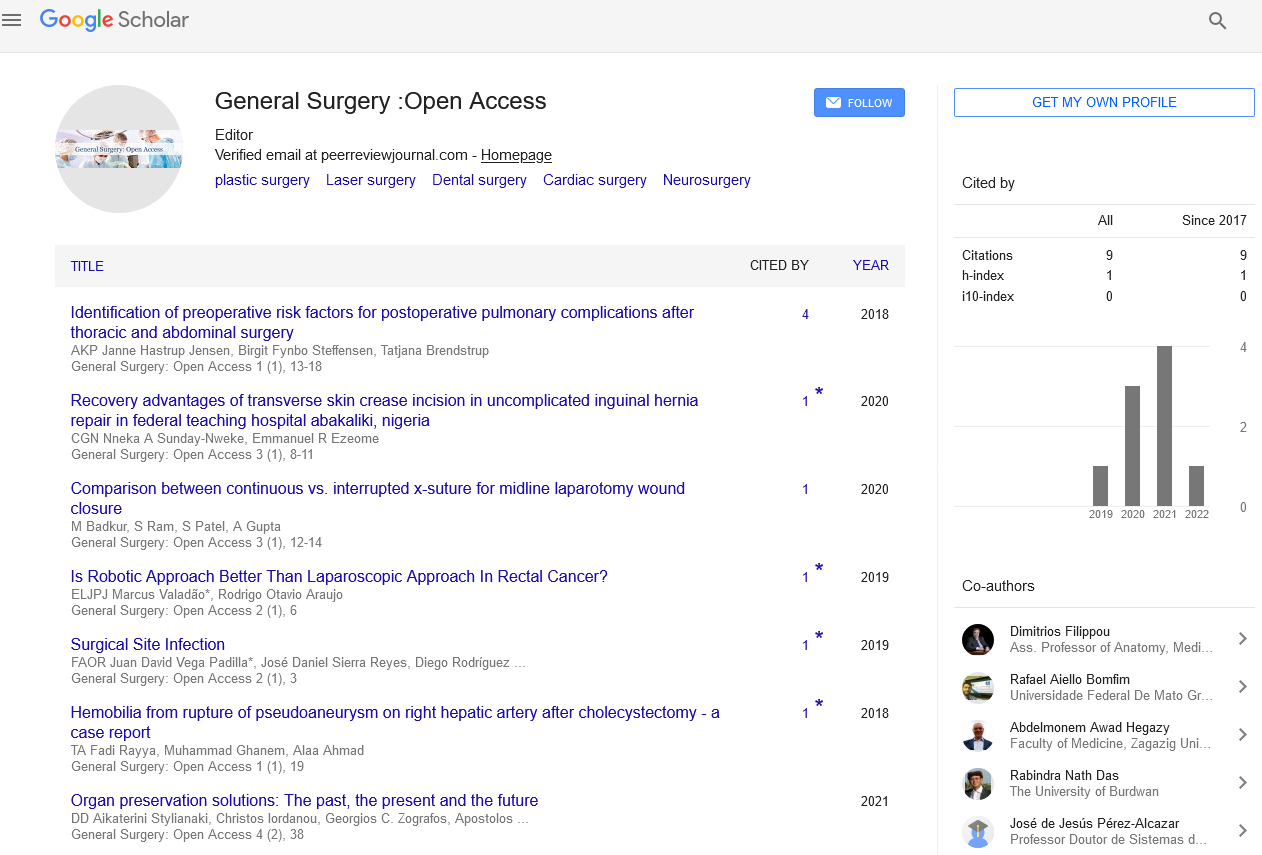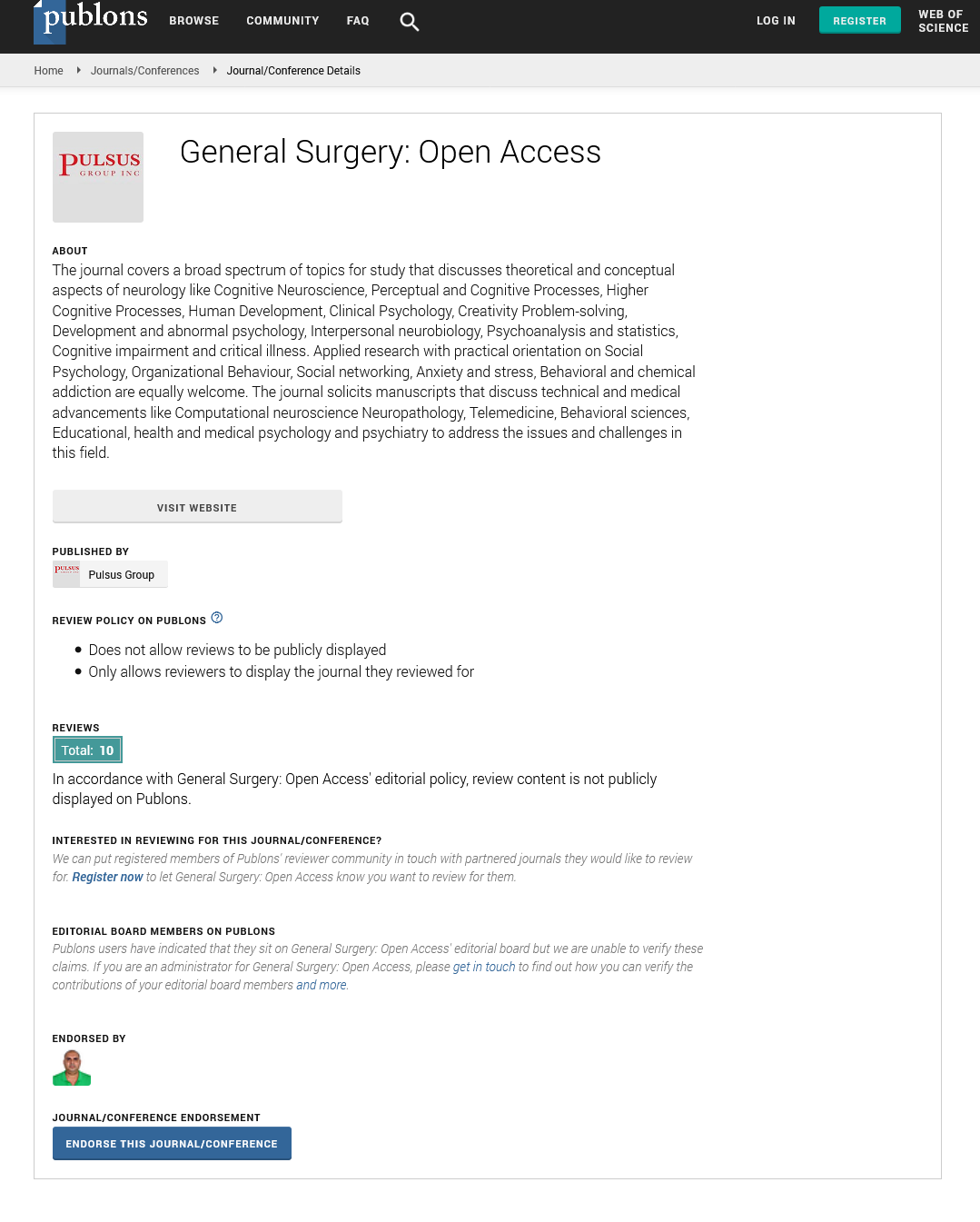Appendix volvulus in an adult male: A case report
Received: 07-Jul-2021 Accepted Date: Jul 21, 2021; Published: 28-Jul-2021
Citation: Foster RA, Grady E M, Hawasli A. Appendix volvulus in an adult male: A case report. Gen Surg: Open Access. 2021;4(5):45-46.
This open-access article is distributed under the terms of the Creative Commons Attribution Non-Commercial License (CC BY-NC) (http://creativecommons.org/licenses/by-nc/4.0/), which permits reuse, distribution and reproduction of the article, provided that the original work is properly cited and the reuse is restricted to noncommercial purposes. For commercial reuse, contact reprints@pulsus.com
Keywords
Appendicular volvulus; Necrosis; Appendicitis
Introduction
Appendicular volvulus is an extremely uncommon cause of acute appendicitis. A literature review reveals limited reports of this condition. Of these case studies, all referred to pediatric cases of appendicitis. Patients typically have classic presentations of acute appendicitis with similar exam and laboratory findings as seen in other causes of appendicitis. The mainstay of therapy is laparoscopic appendectomy. Treatment of appendicular volvulus with antibiotics alone or antibiotics with plan for interval appendectomy will almost certainly lead to necrosis of the appendix and perforation with failure of non-operative management. Unfortunately, this diagnosis appears to only be made with operative evaluation. We present a case of a 35-year old male who was taken to the operating room and found to have appendicular volvulus.
Case Presentation
A 35-year-old male presented to the emergency department with a 1 day history of abdominal pain originating in the periumbilical region that later migrated to the right lower quadrant. He endorsed emesis and anorexia. Upon presentation, he was afebrile and vitally stable. He had a leukocytosis (WBC 12.5 K/mcL) and a normal CRP. A CT scan was performed prior to surgical consultation which demonstrated a dilated appendix with periappendiceal fat stranding concerning for acute appendicitis. No appendicolith was seen. The patient was taken to the operating room for laparoscopic appendectomy. The operation was performed through standard trocar sites. The omentum was peeled off the appendix revealing inflammation consistent with acute appendicitis. The appendix was subsequently suspended freely in the intra-abdominal cavity supported by the mesoappendix. A window in the mesoappendix was created and an endo GIA was utilized to divide the vascular pedicle. Upon division of the mesoappendix and further dissection, the undetected volvulus of the appendix reduced revealing additional length of the appendix. It was volvulized 180 degrees around its pedicle. The area that initially resembled the base was actually 2.5 cm from the true base. A new mesoappendix window was made and a second endo GIA stapler was utilized to transect the actual base of the appendix. Ex-vivo inspection of the specimen revealed a non-obstructing fecalith. Also noted was an area of demarcation about a centimeter from the base, which was ischemic necrosis of the mucosa distal to the volvulus. Pathological review of the specimen denoted acute gangrenous appendicitis with viable mucosa present proximal to the level of volvulus at the base of the appendix. The remainder of the case was without complication and the patient was discharged home late on post-operative day zero.
Results and Discussion
Appendix volvulus has only been reported in case reports, with increasing frequency more recently. A recent report and literature review by Endo et al. provides great detail of the 22 prior English language case reports. The earliest of which was in 1918 [1]. In this case, primary volvulus occurred; there were no masses or mucoceles present to cause the volvulus. No other abnormal findings were noted in the operation, so we do not have a specific reason for the volvulus. This patient presented as acute appendicitis and was managed with early operative intervention. Patients with appendix volvulus are presumed to be at high risk of necrosis of the volvulized portion and perforation if attempts are made to manage them conservatively. As with most reported cases of appendix volvulus, this was diagnosed intra- operatively. Even with CT and US evaluation the volvulus is usually missed. In the 22 prior cases mentioned there is only 1 with a pre-operative diagnosis of appendix volvulus [2].
Ghent and Carnovale (1966) described the etiology, incidence and other factors associated with volvulus of the appendix out of which one was complicated with infection of the wound with gas gangrene. Two cases involved mucocele of the appendix, one was due to the infestation of Schistosoma haematobium where the weighted tip of the infested appendix caused the development of volvulus. The authors have emphasized that the etiological factors ranged from simple obstruction to infection or parasitic infestation.
D’Souza and Abdessalam (2011) have reported a case of a two year old child presented with right lower quadrant abdominal pain that was diagnosed as ruptured appendicitis with abscess. In this case an attempt to computed tomography guided drainage failed to produce purule drainage and the child was subsequently treated with diagnostic laproscopy revealing volvulus of the appendix and subsequently laproscopic appendectomy was performed. The authors have noted that occurrence of volvulus of the appendix is a very rare phenomenon among children [3,4].
Havránek and Hájková (1989) have described the case history of appendix volvulus that developed as a congenital defect in the appendiceal mesenteriolume, wherein, the primary clinical examination did not indicate primary appendicitis but provided enough evidence of strangulation of the aboral part of the appendix.
Laproscopic surgery causing an intestinal volvulus is a very rare post- operative complication. Hegde, et al. reported a rare pediatric case of a young boy who developed an obstruction of the small bowel fooling laproscopic appendectomy for the treatment of perforated appendicitis. The authors have observed that there was no evidence of any congenital malrotation based on initial laproscopy. Subsequent investigation revealed midgut volvulus that necessitated emergency laparotomy. The authors have emphasized on this uncommon complication of laproscopy that would require surgical intervention [5,6].
Baeza-Herrera, et al. reported a case of 7 year old female patient presented with central abdominal pain localized to right lower quadrant with vomiting but not fever. Surgical exploration revealed vermiform appendix torsion. The patient was treated with appendectomy Vermiform appendix torsion is also very rare condition with so far only 25 case being reported in literature.
The following table summarizes the magnitude of appendicitis prevalence in United States of America (Table 1) [7,8].
| Parameter | Year/Gender | Value | Unit |
|---|---|---|---|
| Lifetime risk | male | 8.6 | percent |
| Lifetime risk | female | 6.7 | percent |
| No. of appendectomy is US | 2015 | >300000 | Nos. |
| No. of estimated cases | 2019 | 378614 | Nos. |
| USA Incidence appendicitis | 2004-2008 | 98 | total cases /total person-years |
| USA Incidence appendicitis | 2007 | 120 | total cases /total person-years |
| USA pooled incidence | since 2000 | 108 | incidence per 100,000 with 95% confidence intervals |
Table 1: Risk, prevalence and incidence of appendicitis in USA
Conclusion
The risks of perforation in these patients should prompt early exploration; however, there appears to be no reliable way to make this diagnosis pre- operatively. Although rare, incorrect management of this condition could cause significant morbidity in afflicted patients.
REFERENCES
- Endo K, Sato M, Saga K, et al. Torsion of vermiform appendix: Case report and review of the literature. Surg Case Rep. 2020; 6(1):6.
- Poenaru D, Suarez RA, Fuentes BV, et al. Torsion of vermiform appendix: Value of ultrasonographic findings. EUPSA.1998;8(6):376-377.
- D'Souza GF, Abdessalam S. Volvulus of the appendix: A case report. J Pediatr Surg. 2011;46(8):43-44.
- Havránek P, Hájková H. Volvulus apendix. Rozhl Chir. 1989;68(10):663-665.
- Hegde S, Gosal P, Amaratunga R, et al. Rare occurrence of small bowel volvulus following laparoscopic appendicectomy for perforated appendicitis. J Surg Case Rep. 2019;24(1):9.
- Ghent WR, Carnovale B. Primary volvulus of the appendix. Canadian Medical Association Journal. 1966;95(18):926.
- Herrera CB, García RC, Soria LV, et al. Volvulus of the vermiform appendix. A case report. Rev Med Inst Mex Seguro Soc. 2009;47(4):427-429.
- Ghent WR, Carnovale B. Primary volvulus of the appendix. Canadian Medical Association Journal. 95(18), 926.






